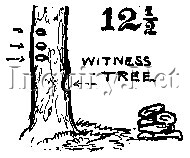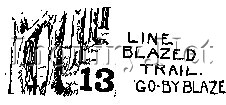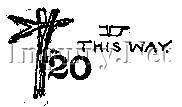By Daniel Beard
When the trees blanketed our continent from the Atlantic Ocean to the Mississippi River with a dark and gloomy forest in which there were only occasional openings, or prairies like those which existed in Indiana and Illinois, it was necessary to mark the trails through the woods in order that one should not become lost.
True, the country was traversed by Big Game trails, war-paths and Indian trails then known as "traces." But many of these, even the celebrated war-paths, were overgrown with underbrush and weeds so as to be only distinguishable to the initiated and accomplished wilderness man.
Hence when the white men came, they marked roads for the settlers. The surveyors and pioneers did this by blazes made with their axes on the tree trunks. These were called blazed trails, "cantiagge," marked trees, by the Long Island Indians and they are still used in the North woods, in Maine, in the wilderness of Canada and the far North, as well as in the few forests remaining in the West.
The blazed trail is either made by chipping pieces of bark off the side of the trees along the line of travel, known as "Go by" blazes (surveyors' marks), or by what is called a "spot-trail," i.e., by making big blazes on the face of the trees along the line, so that one spot may be seen from any other preceding it.
|
WILDERNESS SIGNS OF DIRECTION ON INDIAN TRAILS; GAME TRAILS AND PROSPECTORS' TRAILS; ALSO USED BY GYPSIES, SCOUTS, EXPLORERS AND SPORTSMEN |
|
 |
Fig. 12 1/2. Three blazes on a tree indicate an important "line" tree, or more frequently a witness tree for a corner of plot of land; usually another blaze is made on side of tree nearest the stake or stone marking the corner. |
 |
Fig. 13. Blazed trail. It tells the traveler that a line or trail runs alongside of the points marked. It does not give the particular direction like the arrow because this trail may be followed either way. In the diagram the blazes are much closer than they would be in the wilderness, but it is so made that the reader may more readily understand it. (Surveyors,' trappers,' foresters,' and explorers' sign). |
 |
Fig. 14. Spot trail; useful in traveling after sunset as one blaze may be seen from a position close to any other blaze, but cannot be seen from a position to one side of it, (Hunters,' trappers and foresters' signs.) With surveyors a spot mark indicates a line tree, that is a tree standing on the line; sometimes both a spot and a side blaze is used to show that the line hits the tree on one side. |
 |
Fig. 15. Broken bush trails. When traveling in an unknown country, one bends and breaks the bushes backwards so that their tops point backwards. When retracing one's steps, one's eyes will catch the exposed under surface of the leaves on the broken bushes, thus making it easy to find the way back. (Hunters,' trappers,' and Scout signs.) |
 |
Fig. 16. (Kikaige, I make marks on the road setting up branches -- Chippewa). When a stick is stuck diagonally in the ground, the free point shows the direction to camp. In the Northwest, when an Indian has made a kill of moose, sheep or caribou he puts one end of a fresh willow stick in the ground and wraps a bit of the skin of the dead animal on the end of it as an invitation to anyone coming along that trail to come and eat. If the willow stick is fresh and not withered the traveler knows that food and camp are not far ahead of him, but if the willow stick is wilted and drooping; the traveler knows that it has been there a long time and the hunters have probably eaten up the food supply and hit the trail; but the stick in Fig. 16 simply indicates direction. (Abnaki Indians.) |
 |
Fig. 17. A long upright stick at the end of the pointer tells us that camp is a long distance ahead. (Abnaki Indians.) |
 |
Fig. 18. A short upright stick near the buried end of the pointer tells us that camp is a short distance ahead. (Abnaki Indians.) |
 |
Fig. 19. A number of upright sticks against the leaning stick indicate the number of "sleeps," or days' journey (for the Indian), but with the Boy Scouts of America it tells the number of miles to camp (Abnaki Indians). |
 |
Fig. 20. A cleft stick with a forked stick in the cleft tells us that the direction is pointed by the end of the stick. (Gypsy sign.) A green stick thrust in the mud near the shore of a lake or stream, with a chip in the cleft at the top shows the canoe trail. This is sometimes blazed on side and front to show direction taken by outgoing canoe party. (N. W. Quebec Indians.) |
 |
Fig. 21. A stone on top of another stone tells us that this is the trail. |
 |
Fig. 22. A stone with another stone on top of it and a stone to the right means to turn to the right. (English Boy Scout Sign.) |
 |
Fig. 23. The same with a stone to the left of it reads; "Turn to the left here." (English Boy Scout Sign.) |
 |
Fig. 24. In the prairie and open country a bunch of grass tied together at the top tells us that this is the trail. (Sioux Indian Sign, Dr. Eastman.) |
 |
Fig. 24. If the top ends of the grass are bent to the right it tells us to turn to the right. (Sioux Indian Sign, Dr. Eastman.) |
 |
Fig. 25. If the top of the grass is bent to the left, it tells one to turn to the left. (Sioux Indian Sign. Dr. Eastman.) |
 |
Fig. 27. Two sticks laid on the ground in the form of a "V," indicate the direction same as Fig. 8. (Gypsies.) |
 |
Fig. 28. A row of little stones a laid in the form of a "V" indicates the direction taken. (Gypsies.) |
 |
Fig. 29. A green forked stick laid with apparent carelessness upon the ground to the keen eye of the vagabond tells him that companions have lately passed in this direction. (Gypsies.) |
 |
Fig. 30. The lop-stick. In heavily wooded districts when the attention of a passer-by is required, a prominent tree is selected, a space cleared around it and the branches of the tree lopped off for a considerable distance up the trunk. Such a mark cannot escape the eye of the passer-by. (Alaska Prospectors, Explorers, and Indians.) |
|
If, for instance, one of a party goes ahead and comes to a lake which is
crossed, the water affords no means of marking a trail, but if on the hill or
high bank where he again takes up his trail, a tree is lopped in this manner, it
will attract the immediate attention of those following and enable them to pick
up the trail on the opposite side of the lake. The lop-stick is frequently made
to commemorate some event:
"The next day we dug him a grave above high-water mark . . . . I climbed the tree to make a memorial of the North--the lop-stick." Stefanson. The lop-stick in the wilderness of Canada, now 1918, is frequently a wireless station used probably for war purposes. Several such trees were recently pointed out to the author by wilderness canoe men. |
|
See Also:
Dan Beard's Trail Signs for Danger
Ernest Seton's Trail Signs & Blazes
Traditional Scouting Trail Signs
American Boys' Book of Signs, Signals & Symbols